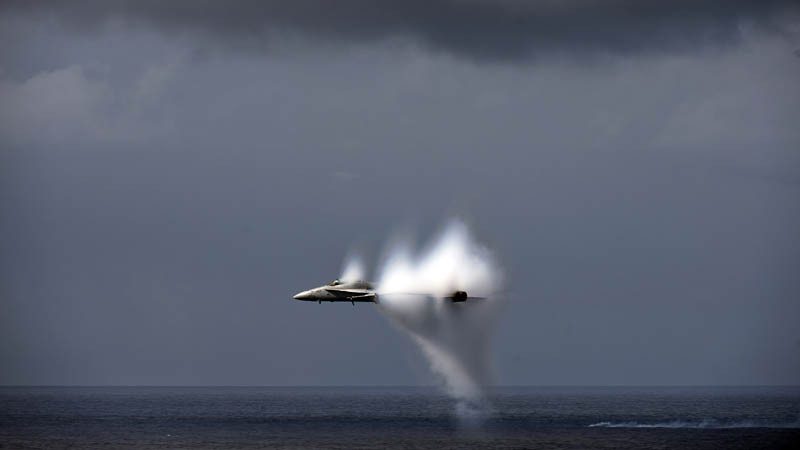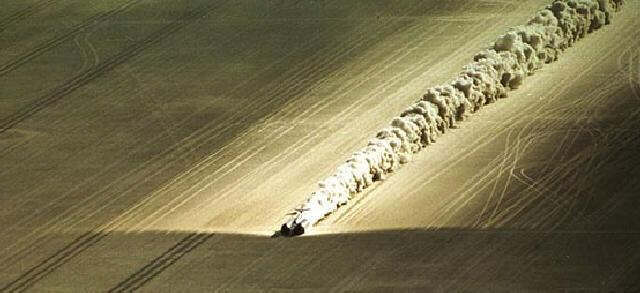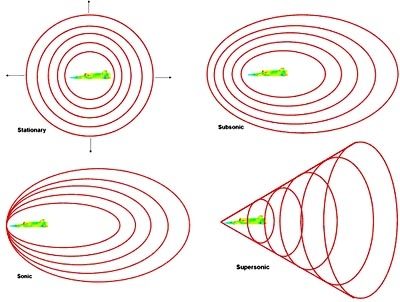GTPNewsWire
Bot
- 23,921

- GTPHQ
This is the discussion thread for a recent post on GTPlanet:
This article was published by Joe Donaldson (@Joey D) on October 31st, 2017 in the Automotive News category.
Jet. The rocket's not until next yearThat's not a car, that's a rocket on wheels.

The FIA website is sending me in circles. Does anyone know the rules for how the wheels have to work? It strikes me that the way to win this thing would be to actually just fly a jet low enough to drag something along the ground.
It turns out that flying at Mach 1 that close to ground isn't especially easy either!The FIA website is sending me in circles. Does anyone know the rules for how the wheels have to work? It strikes me that the way to win this thing would be to actually just fly a jet low enough to drag something along the ground.
That's essentially what's happening. I believe once the car hits 600 mph the wheels can no longer turn as quickly as the car is moving, so they are more or less just a rudder for the vehicle. They are still kind of spinning though.
From what I was told by some folks at Bonneville is that in order to meet the land speed record criteria the vehicle needs only have wheels touching the ground.
It turns out that flying at Mach 1 that close to ground isn't especially easy either!
The outright low altitude speed record is held by an F104 Starfighter, at 988mph and was set in 1977. In this context, low altitude is "below 3km" - and Bloodhound SSC is aiming to beat it at a quarter of that.
From what I understand, the wheels aren't actually super-relevant. It must have them to be an automobile, but they don't need to be driven, and haven't been since Bluebird in the 1960s. The vehicle must be self-propelled and carry its own fuel though.

From what I understand of the regulations it must be a minimum of four wheels to qualify as an automobile - so in essence a jet aircraft doing Mach along a runway with its wheels down would count - if it weren't for the need to meet the definition of a "land vehicle". The Bloodhound team quotes this as:So one could fly a jet and just drag a wheel on the ground? Like.. on a tether? Or does the wheel have to support the weight of the vehicle? Does it have to maintain constant contact or could it skip? How car can it skip? Can it just bounce on a cable, touching once every, say, mile or 2? Does the craft have to be piloted or can we do this with a drone?
Ground effect here permits hovercraft. A Mach hovercraft scares me just thinking about it. It also rules out drones - as it requires the vehicle to be entirely controlled by an on-board driver.Vehicle propelled by its own means in constant contact with the ground (or ice), either directly by mechanical means or indirectly by ground effect, and the motive power and steering system of which are constantly and entirely controlled by a driver on board the vehicle.
When Bloodhound manages to do the 1000mph, will it take the Starfighter's record?The outright low altitude speed record is held by an F104 Starfighter, at 988mph and was set in 1977. In this context, low altitude is "below 3km" - and Bloodhound SSC is aiming to beat it at a quarter of that.
From what I understand of the regulations it must be a minimum of four wheels to qualify as an automobile - so in essence a jet aircraft doing Mach along a runway with its wheels down would count - if it weren't for the need to meet the definition of a "land vehicle". The Bloodhound team quotes this as:
Ground effect here permits hovercraft. A Mach hovercraft scares me just thinking about it. It also rules out drones - as it requires the vehicle to be entirely controlled by an on-board driver.
The record is measured over a flying mile or kilometre (Thrust SSC has 763mph in the flying mile and 760mph in the flying kilometre), over two runs in opposite directions, but from the moment the vehicle starts its run to the moment it stops (which is about 10 miles) it must be a land vehicle.
It would need to be in contact with the floor - at least to the naked eye. The use of movable aerodynamic aids is permitted too, so I can't see any particular reason why you couldn't simply force it into the ground with its existing control surfaces.So a military jet with 4 wheels (tucked inside during the run) flying within ground-effect would count? I'm guessing if someone tried to qualify that they'd change the rules or ban it some other way. The jet in my photograph is probably outside of what one would call "ground effect" but not by a lot. You can make ground effect bigger by adding long thin wings, but that shape is not great for super-sonic flight.
I would expect that the maximum speed achievable would be to fly within ground effect if that's permitted by the rules.
I think the answer is in the FIA's Appendix D.From this definition, we can rule out an aircraft dragging its wheels along the ground through the measured mile (people do ask!),
Only if it all goes badly wrong and the car achieves level flight.When Bloodhound manages to do the 1000mph, will it take the Starfighter's record?
They're 36-inch, solid forged aluminium wheels at 95kg each. And they spin at over 7,000rpm. They're lightweight aluminium so they don't tear themselves apart, with the outer edges subject to 50,000G.They better use very large wheels.
They better use very large wheels.
It would need to be in contact with the floor - at least to the naked eye. The use of movable aerodynamic aids is permitted too, so I can't see any particular reason why you couldn't simply force it into the ground with its existing control surfaces.
Although Bloodhound's website suggests that the rules preclude aeroplanes doing this:
I think the answer is in the FIA's Appendix D.
Only if it all goes badly wrong and the car achieves level flight.
I've never really contemplated the compression wave from supersonic flight hitting the ground before the entire body of the craft had passed. I wonder how they handle the effects of that on this car. I would think that might be pretty damaging on a loose surface. One more reason to stick with paved surfaces.


If the South African Pans are anything like the Bonneville Salt Flats, they're incredibly well packed. Even before Speed Week they spend weeks preparing the surface by packing it tighter, making it smoother, and removing anything remotely loose. I'm guessing they'll prep the hell out of the 12 mile course before they attempt to hit 650, 800, or 1000 mph.
https://www.popsci.com/1000mph#page-4Wind-tunnel tests are of little help in developing supersonic land vehicles. The winds aren't sufficiently strong in a wind tunnel, and, as Noble points out, it's how a supersonic shock wave interacts with the ground and the underside of the vehicle that's the question. The moving floors in wind tunnels used to test racecars simply don't go fast enough to replicate the forces a vehicle will experience at 800-plus mph. Instead the team has to make these calculations using computational fluid-dynamics, greatly improved since Noble's Thrust SSC days, in which supercomputers simulate how air will interact with the car's moving body and the ground beneath it. According to simulations conducted at the team's satellite office at Swansea University in Wales, at 1,000 miles per hour, 12 tons of air pressure will push against every square inch of Bloodhound SSC's aluminum body.
http://www.bloodhoundssc.com/project/car/aerodynamicsShock waves on a supersonic vehicle
Shock waves form because of the nature of the propagation of sound waves through the air.
Under normal subsonic conditions, any body, whether it be a jogger or Formula 1 car, transmits pressure disturbances ahead of it in the form of sound waves. These waves carry the ‘information’ to the air molecules ahead of it so they have advance warning that the body is coming and that they need to start moving out of the way. However, when the body itself is travelling at the same speed (sonic) or faster (supersonic) than the speed of these sound waves, it can no longer transmit this information forward and the waves ‘bunch up’ right in front of the vehicle forming a shock wave which we experience in the form of an audible ‘sonic boom’.
When this happens, the flow properties (for example pressure and density) around the vehicle no longer vary smoothly but change rapidly at the shock waves. You can see this in the picture at the top of this page which simulates the pressure contours over one of the early BLOODHOUND designs travelling at Mach 1.3 (that is 1.3 times the speed of sound).
Understanding how these shock waves interact with the Car and with the desert surface has therefore been a crucial part of the aerodynamic research for the BLOODHOUND programme.
Actually you've reminded me that Noble and Green told me* it was the transonic speeds that are the major problem and it all smooths out once you get properly supersonic. Thrust SSC was a bit of a pig on that basis as it was largely milling around Mach 1 and many of its flying runs were in and out of the transonic range. Bloodhound will get transonic twice - once on the way up, and once on the way down - and should punch right through it on the way to its flying Mach 1.3.This is a really nasty problem. Shock waves reflecting off the ground, launching debris, creating unstable lift on different parts of the vehicle as you transition past the sound barrier, it's a lot more to deal with than a supersonic jet. Very cool work.
Actually you've reminded me that Noble and Green told me* it was the transonic speeds that are the major problem and it all smooths out once you get properly supersonic. Thrust SSC was a bit of a pig on that basis as it was largely milling around Mach 1 and many of its flying runs were in and out of the transonic range. Bloodhound will get transonic twice - once on the way up, and once on the way down - and should punch right through it on the way to its flying Mach 1.3.
*Don't mind me swinging my penis around just over here - I interviewed them both last year at Bloodhound HQ. Noble was a childhood hero of mine, so I was a bit fangirly
Interesting.
Well if it can hover, even a tiny amount, that's got to be optimal. Maybe it's impactical because it would require too much control, or entail too much risk to the driver, but rolling on the ground is a loss. If you have aerodynamic surfaces that you can use to control hovering flight, that would be the way to do it. Forcing it to the ground increases drag from the aerodynamic surfaces and wheels. Maybe it's just too dangerous (for now).
Edit:
I've never really contemplated the compression wave from supersonic flight hitting the ground before the entire body of the craft had passed. I wonder how they handle the effects of that on this car. I would think that might be pretty damaging on a loose surface. One more reason to stick with paved surfaces.
I think it would be hard to design a 1000 mph hovercraft. It would be difficult to maintain a steady attitude and gap to the ground and the skirt would have the potential to pick up a ton of aerodynamic forces and send the craft flying in all sorts of directions.
It would also have to be at least as aerodynamic as the car, or else the increased drag would cost more than what's gained by losing the wheels.
There are a few aircraft that were designed with these conditions in mind. Low altitude deep penetration bombers like the B-1B, F-111, and Tornado. I'm unsure exactly how low and fast they would typically fly, but on paper they were to hug the ground at super/transonic speed to avoid radar. NASA might have some papers relating to test flights or scale model testing. Probably more on the F-111 since it's American and older.This is a really nasty problem. Shock waves reflecting off the ground, launching debris, creating unstable lift on different parts of the vehicle as you transition past the sound barrier, it's a lot more to deal with than a supersonic jet. Very cool work.
There are a few aircraft that were designed with these conditions in mind. Low altitude deep penetration bombers like the B-1B, F-111, and Tornado. I'm unsure exactly how low and fast they would typically fly, but on paper they were to hug the ground at super/transonic speed to avoid radar. NASA might have some papers relating to test flights or scale model testing. Probably more on the F-111 since it's American and older.
There have also been waveriders like the XB-70, though it was intended for high altitude flight. I wonder how adaptable it would be to low altitudes. The B-70 high altitude mission was changed to low altitude after Soviet SAM technology evolved, but it was no longer capable of supersonic flight with the new profiles.
Yeah, I don't know how feasible it is, I just figured that those aircraft might give some ideas on the limits of low level flight.Still, at a minimum, you'd have to get low enough that the shockwave hits the ground within the length of the aircraft. I don't think it's possible to fly supersonic that low with those aircraft.